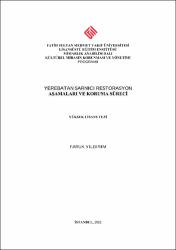| dc.contributor.advisor | Saatçi, Suphi | |
| dc.contributor.author | Yıldırım, Faruk | |
| dc.date.accessioned | 2021-08-19T15:36:00Z | |
| dc.date.available | 2021-08-19T15:36:00Z | |
| dc.date.issued | 2021 | en_US |
| dc.identifier.citation | YILDIRIM, Faruk, Yerebatan Sarnıcı Restorasyon Aşamaları ve Koruma Süreci, Fatih Sultan Mehmet Vakıf Üniversitesi Lisansüstü Eğitim Enstitüsü Mimarlık Anabilim Dalı Kültürel Mirasın Korunması Ve Yönetimi Programı, Yayımlanmamış Yüksek Lisans Tezi, İstanbul 2021. | en_US |
| dc.identifier.uri | https://hdl.handle.net/11352/3832 | |
| dc.description.abstract | Halk arasında “Yerebatan Sarayı” olarak dile getirilen Yerebatan Sarnıcı, İstanbul’un Fatih semtinde, Ayasofya’nın güneybatısında, dünyanın sıfır noktası olarak addedilen Milyon (Million) Taşı’nın yanında, Bizans üçgeninin diğer iki kolu olan Filoksenus Cistern (Binbirdirek Sarnıcı) Teodosus Cistern (Şerefiye Sarnıcı) ve Konstantinopolis’ten önce inşa edilmiş Akhilleus ve Zeuksipposs hamamları ile aynı bölgede konumlanmaktadır.
Birbirinden farklı kültür, medeniyet ve inancın bir arada yaşayıp süregeldiği uygarlıklar beşiği İstanbul’un abidevi eserlerinden, Roma’nın en önemli caddesi olan Mese’nin merkezinde, Binbirdirek sarnıcının batısında konumlanan, daha önce üzerinde var olan Basilika Stoa adlı yapının ve bölgenin su ihtiyacını karşılamak için yapıldığı tahmin edilen 140 metre uzunluğa, 79 m genişliğe, 9.800 m2 taban alanı ile yaklaşık 100.000 ton su depolama kapasitesine sahip Yerabatan Sarnıcı, Bizans İmparatoru I. Justinianus’un emriyle 6.yüzyılda inşa edilmiştir. Tez çalışmamda 1500 yıllık tarihi ile Bizans devrinin günümüze kadar gelmiş en önemli kültürel miraslarından biri olan Yerebatan Sarnıcı’nın önemi, tarihsel gelişimi, Tarihi Yarımada içindeki konumu, yapının çevre ile ilişkisi, koruma süreci, müteakip devirlerde geçirdiği onarım, müdahale, restorasyon aşamaları, resmi kararlar bağlamında kronolojik envanter oluşturacak şekilde detaylı olarak aktarılmıştır. | en_US |
| dc.description.abstract | The Basilica Cistern, referred to as the “Basilica Palace” among the public, is located in the Fatih district of Istanbul, southwest of Hagia Sophia, next to the Milion Stone, which is considered to be the zero point of the world. The cistern is in the same region with the other two branches of the Byzantine triangle, the Phylloxenus Cistern (Binbirdirek Cistern) and Teodosus Cistern (Şerefiye Cistern), and also the Achilles and Zeuksipposs baths built before Constantinople.
The Basilica Cistern is one of the monumental works of Istanbul, the cradle of civilizations where different cultures, civilizations and beliefs coexist and persist. It is located in the center of Mese, the most important street of Rome, in the west of Binbirdirek Cistern. It was built in the 6th century by the order of the Byzantine Emperor I.Justinianus. It is estimated that the cistern was built to meet the water needs of the region and the building named Basilika Stoa, which was on it before. It has a length of 140 meters and a width of 79 m, and its floor area is 9,800 m2, water storage capacity is approximately 100,000 tons. In my thesis, the importance and historical development of the Basilica Cistern, which is one of the most important cultural heritages of the Byzantine period with its 1500-year history, has been discussed. The location of the cistern in the Historic Peninsula, the relationship of the building with the environment, the conservation process, the repair, intervention and restoration stages it underwent in the following periods; were presented in detail to create a chronological inventory in the context of official decisions. | en_US |
| dc.language.iso | tur | en_US |
| dc.publisher | Fatih Sultan Mehmet Vakıf Üniversitesi, Lisansüstü Eğitim Enstitüsü | en_US |
| dc.rights | info:eu-repo/semantics/openAccess | en_US |
| dc.subject | İstanbul | en_US |
| dc.subject | Yerebatan Sarnıcı Restorasyon Aşamaları | en_US |
| dc.subject | Müteakip Devirlerde Geçirdiği Onarımlar Ve Müdahaleler | en_US |
| dc.subject | Koruma Süreci | en_US |
| dc.subject | Basilica Cistern | en_US |
| dc.subject | Restoration Stages | en_US |
| dc.subject | Repairs and Interventions | en_US |
| dc.subject | Preservation Process | en_US |
| dc.title | Yerebatan Sarnıcı Restorasyon Aşamaları Ve Koruma Süreci | en_US |
| dc.title.alternative | Basilica Cistern’s Restoration Stages And Conservation Process | en_US |
| dc.type | masterThesis | en_US |
| dc.contributor.department | FSM Vakıf Üniversitesi, Lisansüstü Eğitim Enstitüsü, Mimarlık Ana Bilim Dalı Ana Bilim Dalı | en_US |
| dc.relation.publicationcategory | Tez | en_US |
| dc.contributor.institutionauthor | Yıldırım, Faruk | |



















